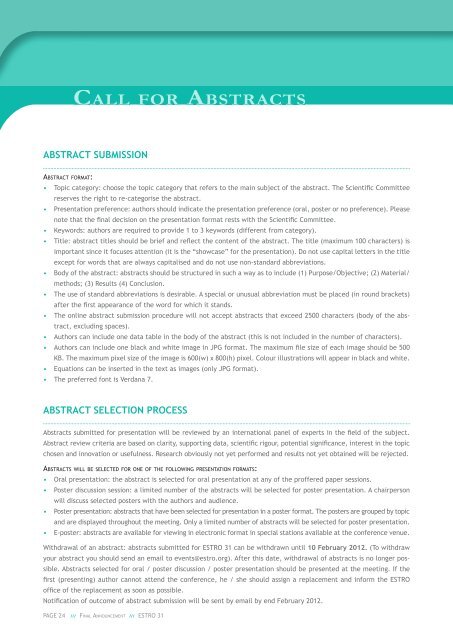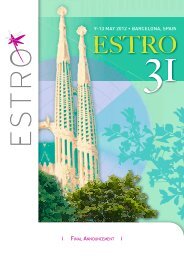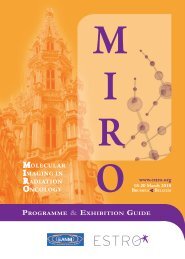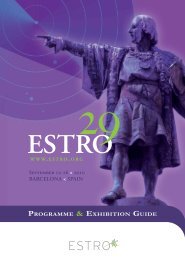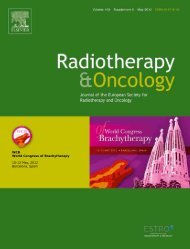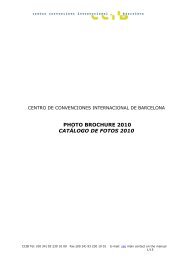9-13 May 2012 • Barcelona, Spain - Estro-events.org
9-13 May 2012 • Barcelona, Spain - Estro-events.org
9-13 May 2012 • Barcelona, Spain - Estro-events.org
Create successful ePaper yourself
Turn your PDF publications into a flip-book with our unique Google optimized e-Paper software.
ABSTRACT SuBMISSION<br />
abstract Format:<br />
Call all for abstra bstraCts ts<br />
<strong>•</strong> Topic category: choose the topic category that refers to the main subject of the abstract. The Scientific Committee<br />
reserves the right to re-categorise the abstract.<br />
<strong>•</strong> Presentation preference: authors should indicate the presentation preference (oral, poster or no preference). Please<br />
note that the final decision on the presentation format rests with the Scientific Committee.<br />
<strong>•</strong> Keywords: authors are required to provide 1 to 3 keywords (different from category).<br />
<strong>•</strong> Title: abstract titles should be brief and reflect the content of the abstract. The title (maximum 100 characters) is<br />
important since it focuses attention (it is the “showcase” for the presentation). Do not use capital letters in the title<br />
except for words that are always capitalised and do not use non-standard abbreviations.<br />
<strong>•</strong> body of the abstract: abstracts should be structured in such a way as to include (1) Purpose/Objective; (2) Material/<br />
methods; (3) Results (4) Conclusion.<br />
<strong>•</strong> The use of standard abbreviations is desirable. a special or unusual abbreviation must be placed (in round brackets)<br />
after the first appearance of the word for which it stands.<br />
<strong>•</strong> The online abstract submission procedure will not accept abstracts that exceed 2500 characters (body of the abstract,<br />
excluding spaces).<br />
<strong>•</strong> authors can include one data table in the body of the abstract (this is not included in the number of characters).<br />
<strong>•</strong> authors can include one black and white image in JPg format. The maximum file size of each image should be 500<br />
Kb. The maximum pixel size of the image is 600(w) x 800(h) pixel. Colour illustrations will appear in black and white.<br />
<strong>•</strong> equations can be inserted in the text as images (only JPg format).<br />
<strong>•</strong> The preferred font is Verdana 7.<br />
ABSTRACT SELECTION PROCESS<br />
abstracts submitted for presentation will be reviewed by an international panel of experts in the field of the subject.<br />
abstract review criteria are based on clarity, supporting data, scientific rigour, potential significance, interest in the topic<br />
chosen and innovation or usefulness. Research obviously not yet performed and results not yet obtained will be rejected.<br />
abstracts WIll be selected For one oF the FolloWIng presentatIon Formats:<br />
<strong>•</strong> Oral presentation: the abstract is selected for oral presentation at any of the proffered paper sessions.<br />
<strong>•</strong> Poster discussion session: a limited number of the abstracts will be selected for poster presentation. a chairperson<br />
will discuss selected posters with the authors and audience.<br />
<strong>•</strong> Poster presentation: abstracts that have been selected for presentation in a poster format. The posters are grouped by topic<br />
and are displayed throughout the meeting. Only a limited number of abstracts will be selected for poster presentation.<br />
<strong>•</strong> e-poster: abstracts are available for viewing in electronic format in special stations available at the conference venue.<br />
Withdrawal of an abstract: abstracts submitted for eSTRO 31 can be withdrawn until 10 February <strong>2012</strong>. (To withdraw<br />
your abstract you should send an email to <strong>events</strong>@estro.<strong>org</strong>). after this date, withdrawal of abstracts is no longer possible.<br />
abstracts selected for oral / poster discussion / poster presentation should be presented at the meeting. If the<br />
first (presenting) author cannot attend the conference, he / she should assign a replacement and inform the eSTRO<br />
office of the replacement as soon as possible.<br />
notification of outcome of abstract submission will be sent by email by end February <strong>2012</strong>.<br />
LATE-BREAKINg ABSTRACTS<br />
ESTRO<br />
31<br />
<strong>2012</strong><br />
<strong>•</strong> The work and/or update must be novel, ground-breaking, of high significance, evidence-based and with scientific merit.<br />
<strong>•</strong> The work and/or update must be original and not previously have been published or presented at any other scientific meeting.<br />
<strong>•</strong> The abstract must present timely findings that were not available at the time of the deadline (16 January <strong>2012</strong>). The<br />
late breaking abstract deadline is not intended to be a second deadline for abstract submissions.<br />
<strong>•</strong> a limited number of late-breaking abstracts will be accepted.<br />
<strong>•</strong> Submissions will be accepted for oral presentation only.<br />
<strong>•</strong> The deadline for late-breaking abstracts is 20 March <strong>2012</strong>.<br />
ABSTRACT TOPIC CATEgORIES<br />
ClInIcal track<br />
1. CnS and haematology<br />
2. Head and neck<br />
3. Lung<br />
4. breast<br />
5. gastrointestinal tumours (upper and lower gI)<br />
6. genitourinary (prostate included)<br />
7. gynaecological tumours<br />
8. Sarcoma<br />
9. Paediatrics<br />
10. elderly<br />
11. Palliation/supportive care/patient support<br />
12. Stereotactic RT<br />
<strong>13</strong>. Target and volume definition and imaging<br />
14. Health economics<br />
15. Other tumour sites<br />
PhysIcs track<br />
16. basic dosimetry and phantom and detector developments/characterisation<br />
17. Dose measurements<br />
18. Dose calculation<br />
19. Treatment planning and comparisons<br />
20. Treatment plan optimisation<br />
21. Radiobiological modelling<br />
22. Intrafraction motion management<br />
23. Management of interfraction changes<br />
24. Imaging: focus on clinical applications<br />
25. Imaging: focus on Qa and technical aspects<br />
26. Implementation of technology, techniques, clinical<br />
protocols or trials<br />
27. Radiation protection<br />
28. Professional and educational issues<br />
29. Others<br />
radIobIology track<br />
30. Molecular targeted agents and radiotherapy<br />
31. The Dna damage response<br />
32. genomics and proteomics<br />
33. Tumour microenvironment, hypoxia & angiogenesis<br />
34. normal tissue effects: pathogenesis and treatment<br />
35. Predictive assays/prognostic factors<br />
36. novel radiation modalities - particles, high LeT<br />
37. Time dose fractionation<br />
38. Signal transduction<br />
39. Others<br />
RTT track<br />
40. Patient preparation, patient immobilization<br />
and support aids<br />
41. Treatment planning and dose calculation<br />
42. Volume definition, treatment margins and geometric<br />
uncertainties<br />
43. Patient care<br />
44. education and training<br />
Page 24 /// FInal announcement /// eSTRO 31 eSTRO 31 /// FInal announcement /// Page 25


